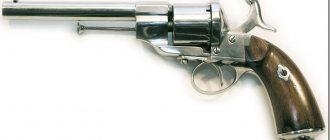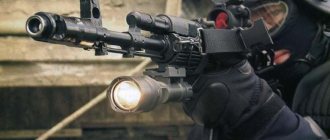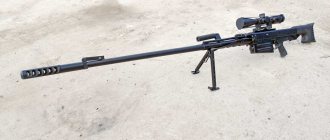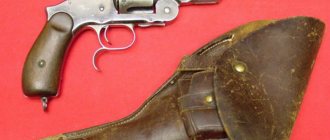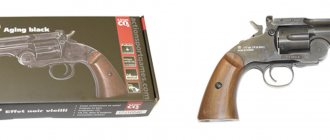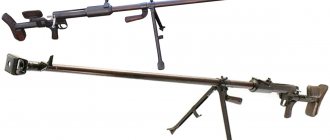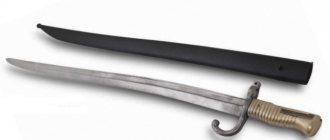From Pepperbox to the predecessor of Nagan
The reason for half a century of success is that these small arms were developed for a unitary cartridge, later they used a double-action trigger mechanism, they were not afraid of dampness, and the revolver could be loaded or unloaded even in complete darkness.
In addition, the production of Lefoshe revolvers was so simple that it was produced not only by European arms factories, but also by small workshops, and with the advent of the central ignition cartridge, these small arms were easily converted to fit this cartridge.
“Perelomka”, ammunition, “Bundelrevolver”
Master Casimir Lefauchet, born on January 26, 1802 in France, in the commune of Bonnetable, Sarthe department, Pays de la Loire region, received his first gunsmith patent in 1827 for the creation of a hunting rifle.
In 1832, he patented a new double-barreled hunting rifle, the famous “breakthrough,” various modifications of which are still enjoyed by hundreds of thousands of hunters around the world. This invention forever brought his name into the history of weapons. But the weapons and ammunition he created brought worldwide fame to the gunsmith.
In 1836, the gunsmith completed the development of a new cartridge, which would later be called the pin cartridge. It had a cardboard sleeve. Later, Casimir Lefoshe created a revolver that received his name and was designed specifically for this ammunition. This created a real revolution in France, and later throughout the world.
The first in this line of weapons was a 6-barrel revolver-type Pepperbox, the barrels of which rotated. This design was called a “bundelrevolver”. It was a revolver designed for a cartridge called the hairpin cartridge. The weapon was released in 1846. And 5 years later, at one of the exhibitions, one of its copies was shown to the London public.
In 1852, having become famous far beyond the borders of his country in a relatively short time, Casimir Lefoshe dies. The life's work of the gunsmith designer was continued by his son Eugene. A year after the death of his father, thanks to the efforts of his son-follower, a new army, drum model of a revolver was adopted, the ammunition for which was the hairpin cartridges invented by Casimir Lefoshe.
New weapons
It was the first revolver loaded with a unitary cartridge with a metal sleeve. Its barrel-shaped magazine contained 6 pin cartridges, located so that the metal pin-rod protruding from each cartridge case was hit by the striker when the drum chamber moved.
After the rod hit the upper end of the pin, its second end transmitted the blow with its sharp end to the primer, causing the latter to explode, igniting the gunpowder. And its gases pushed the bullet out of the cartridge case.
The use of a fundamentally new approach in the manufacture of ammunition for small arms, which made the great Frenchman famous, was not the only innovation in this. The revolver could be fired not only after manually cocking the hammer, but also by self-cocking, simply by pressing the trigger.
The French army was the first in the world to arm itself with a new modification of the revolver. And since then, throughout the world, this weapon has been firmly associated as the Lefoshe revolver, or the revolver of the French system. By the way, if earlier pin cartridges had a cardboard shell, then this model of revolver had a metal sleeve, and the revolver of this system spread widely throughout Europe.
Distribution throughout Europe
During the war, called the Crimean War, by order of the French government, tests were carried out on hairpin revolvers, on which, in addition, they tested the Colt created by Samuel Colt for mounted riflemen of the American army and the capsule revolver of the Adams system, the so-called English Beaumont, modified by the English designer Frederick Beaumont. -Adams.
As a result, it was the model of the father and son Lefoshe that was adopted by the French naval forces (the revolver received another name - the Marine Lefoshe). And in 1858, the Italian navy also armed itself with it.
And a year after that, revolvers of the Lefoshe system were tested in Russia. They were held at the shooting school for officers and the revolver, having successfully passed all the tests, emerged victorious among other competitors. In his assessment, the simplicity and use of a unitary cartridge played a decisive role.
Its deliveries were not long in coming. The first order for 4,500 units of these revolvers was received by Lefoshe himself. In addition, 1,600 units were ordered in Belgium, at the Tanner factory. Another 1,000 were produced by the craftsmen of the Sestroretsk plant, and in 1871 the Main Artillery Directorate of the Russian Army placed an order for the production of 500 units of these weapons to the gunsmiths from Tula Goltyakov.
The first to arm themselves with these revolvers were the junior ranks of the Russian gendarmerie. Lefoshe revolvers were not officially accepted for service, therefore, army officers purchased them at their own expense. It should be noted that until this moment the Russian army used standard smoothbore pistols, which cannot be compared with the new type of weapon.
Lefoshe hairpin revolvers were copied in many countries. Very soon, mass production was established in European countries (Austria-Hungary, Belgium, Germany, Spain and others). Factory production of pin weapons, both revolvers and shotguns, and ammunition for them, began to decline only at the beginning of the 20th century. And one of the reasons for its longevity was its ease of use and its well-established inexpensive production in many countries.
Lefoshe hairpin
The scroll on the trigger guard became a decoration characteristic of European hunting weapons.
The first cartridges appeared in the 1500s and immediately found wide application in military and hunting weapons. To load the cartridge, the cartridge was opened, gunpowder was poured into the barrel and onto the lock shelf, and a paper cartridge was used as a wad. Of course, this speeded up the loading of muzzle-loading weapons, but... I wanted “even faster.” A real breakthrough in the improvement of firearms is associated with the name of the brilliant gunsmith, Swiss artillery officer Samuel Johannes Pauli, who worked in Paris. In 1808, he patented the first weapon in history to use a unitary center-fire cartridge. The principle of igniting a charge in a gun of this design was similar to the modern one; today these systems are commonly called needle systems. Pauli's advanced ideas were not translated into mass production, but became the basis for more enterprising, albeit less talented gunsmiths.
In 1831, the so-called Dimedion system became famous, where breech-loading guns use a cartridge with a special capsule in the form of a tube protruding from the side of the cartridge base. This weapon was also not widely used due to the impracticality of the cartridge. Around the same years, the so-called “Saint-Eard” system appeared in France, the cartridge of which contained pins protruding on the sides.
| The highlight of the design of the Lefoshe system fitting is the curved neck of the butt. The most difficult thing in the manufacture of this fairly loaded “unit” is to ensure strength. |
The existing developments in the field of designing modern weapons were summarized by the French gunsmith Casimir Lefauchet, who in 1836 proposed a very successful design of a gun and cartridge. The Lefoshe unitary cartridge was a folder type with a brass cap and a metal pin protruding from the outside, which “rested” on the capsule inside the cartridge. When the pin was hit, the primer was triggered and the charge ignited. Oddly enough, all modern hunting shotgun and slug rifle cartridges are nothing more than Lefoshe cartridges with a modified position of the primer in the bottom of the cartridge case. Moreover, all the main sizes of such cartridges have remained to this day practically unchanged, except that some exotic calibers have been forgotten, for example, the once very common 14th.
| DRUM DOOR. Today, the hinged cylinder door seems to be an integral part of antique revolver designs. Indeed, almost all the oldest revolvers are chambered for unitary pin cartridges “with a door”. The latch button is pressed, the door swings back, and the cartridges are inserted one by one into the chambers of the drum, and the spent cartridges are also extracted one at a time. Already in the middle of the 19th century, breaking and sliding revolving systems appeared, which made it possible to get away from the inconvenient, albeit reliable, “door” scheme. In Russia, the most famous such archaic design is the Nagan system revolver. On the basis of this system, which was hopelessly outdated in the second half of the 19th century, the USSR produced military and sporting weapons for a long time, and today a small-caliber carbine. |
| When loading the fitting, it is necessary to orient the cartridge with the pin up so that it fits into a special cutout in the breech of the barrel. |
Lefoshe combined the percussion cap lock and his cartridge together.
His gun had a barrel that swung on a hinge. For strong adhesion of the barrel to the block, a latch was used that fit into the cutout of the hook under the barrels. The valve was controlled by a long lever located under the block and fore-end. To load such a gun, it was necessary to turn the lever, move the breech up from the block, insert the cartridge so that the pin would fall into the cutout on top of the breech section of the barrel, close the barrel and return the lever to its original position. To fire, it was necessary to manually cock the trigger; when the trigger was pressed, the trigger broke and hit the protruding cartridge pin. An extractor was not needed in such a weapon: the cartridge case was easily removed manually using the same pin. Such guns were loaded quite quickly; the folder casing was suitable for repeated reloading. The single-barrel carbine, developed by Casimir Lefoshe, was not considered suitable for army service due to its swinging barrel. But hunting break-in single-barreled and double-barreled shotguns and rifles have become widespread. The French gunsmith did not stop there and continued to improve his weapon: instead of a bolt, the barrel began to be locked with a screw head, which, when turned, attracted the barrel to the block with its surfaces.
| The open frame has become a distinctive feature of revolving designs chambered for Lefoshe cartridges. The absence of an upper lintel reduced the rigidity of the structure. |
Such a successful and original solution found a considerable number of imitators, and eminent ones at that. For example, the Birmingham shutter, which has become a legend, is nothing more than a slightly modified design by Casimir Lefoshe. It was patented by the English arms manufacturer Lancaster, under whose name it is widely known today. After the pin cartridge was replaced by center-fire ammunition, the life of the old guns did not end; they were easily converted to new center-fire cartridges, and many hunting weapons from the 19th century were preserved in this form.
| The Lorona revolving carbine is similar to the Lefoshe systems only by the type of cartridge: on the cut of the drum there are “standard” grooves for pins. |
| DANGEROUS PROMOTION. The main disadvantage of hairpin cartridges was... the hairpin itself. It’s easy to imagine what will happen when the cartridge falls and hits it. In some countries, revolvers of the Lefoshe system nevertheless entered service with the army and navy, and in the Russian Empire, after research, these weapons were considered unsuitable due to the “dangerous cartridge”, while noting the success of the design as a whole. For hunters, such a cartridge did not become a hindrance and continued to be produced for a long time, just like hunting weapons for it. |
How many hairpin weapons have survived unchanged to this day? The familiar double-barreled shotguns are found quite often, but unusual weapons, in which one can see gunsmiths searching for ways to further improve hunting systems or perform any specific tasks, can be seen infrequently. One of the brightest representatives of such weapons can be considered a single-barreled rifled shotgun, built according to the classical principles of Casimir Lefoshe. The magnificent octagonal 20-gauge 760 mm long Damascus barrel with eight rifling is securely locked using a mechanism controlled by an under-barrel lever. There is a “hairpin” groove on the cut of the breech. Parts of the gun are covered with harmonious, elegant engraving. It seems that everything is standard and understandable, but there is a highlight in this fitting that does not let you pass it by... The most interesting thing about it is the back part of the block, which connects to the neck of the butt, and the butt itself too. This unit is artificially bent, the axis of the barrel is at an angle to the shanks of the block, and it turns out that the butt is to the right of the barrel. Apart from this, everything else in the butt corresponds to the accepted canons; there is even a cheek piece for the convenience of the insert. Such weapons are quite difficult to produce. Technologies for manufacturing high-quality rifled barrels and geometrically complex steel parts and assemblies were well known in the 19th century and were used in many industrial centers. If there were no insurmountable difficulties during production with the steel parts, then it was not easy to make the curved wooden neck of the butt: to ensure the strength of the structure, special wood with the required bending of the fibers was selected. It would seem, why do we need such an unusual weapon - complex and, as a result, expensive? Today we know how much the cost of a serial shotgun or rifle, to which such a change is made upon special order, can increase: it will become many times more expensive. The design of the fitting shows that it is intended for right-handed people. We can give a clear answer: it makes sense to use such a bend for a hunter with the dominant left eye - this is not so rare. The number 59 is stamped on top of the gun mechanism key. What is this: the serial number of similar guns or the general numbering of products produced by a gunsmith or arms factory is impossible to say today. We can only state that this manufacturer had very, very great experience in manufacturing weapons.
| The folding bayonet of the Lorona carbine. The spring design allows you to bring the bayonet into a “combat ready state” almost instantly. |
Such a rifled gun, despite its original design, can be called a classic version of the hunting rifle developed by Casimir Lefoshe. Back in the 1840s, this gunsmith used pin cartridges in revolvers. Lefoshe's revolvers were simple, loading was carried out one cartridge at a time with the drum door folded back, the revolver frame was not closed and was connected to the barrel block using a simple connection fixed with a screw. A manual cleaning rod-extractor was attached to the right of the receiver block, through which spent cartridges were removed from the drum one by one.
| The barrel block and drum of the Loron carbine are fixed on a central axis protruding from the drum frame. |
Today, systems based on Lefauchet's ideas include the carbine of the Belgian gunsmith Pierre Antoine Laurent. This 12-mm revolver carbine with six grooves in the barrel is similar to Lefoshe systems only in the type of cartridge: on the cut of the drum there are “standard” grooves for pins. But loading it is very original: the carbine has an unusual frame opening design. In order to move the barrel unit forward, you need to turn the lever mounted on the left side of the frame 90 degrees, after which the barrel moves forward along the long axis. The same lever is used to extract spent cartridges. You just need to turn it another 90 degrees. The lever-operated locking system does more than just lock the barrel and frame into place. Its cam mechanism presses the barrel block against the drum, that is, the design of the carbine initially included the ability to compensate for the wear of its parts that appears during significant shooting. There is an actual “pulling up of the structure”, which begins to become loose. In addition, such a device avoids the main drawback of revolving systems - the increase in the gap between the barrel and the drum, through which gases are released when fired.
The Loron carbine contains an interesting element - a bayonet, characteristic exclusively of army systems. It would seem that having a bayonet on a multi-shot hunting weapon in the 19th century was pointless. What forced it to be placed on a 600 mm carbine barrel? The design of the bayonet means that with the help of a spring and a latch it can be thrown forward at any time and locked in the “combat” position. Fast and easy! Of course, a bayonet doesn’t make much sense when hunting, but it can come in handy when traveling.
Alexey Klishin December 11, 2013 at 00:00
Rare specimens
In addition to the revolvers that were widely used in dozens of countries, Lefoshe also designed quite rare specimens, which were nevertheless in demand among some exotic lovers. This series includes Lefoshe double-barreled hairpin revolvers with 18-20 rounds and a Lefoshe 12-shot hairpin revolver (there is also a very rare 21-shot hairpin revolver).
There was and is fierce competition in the arms market. This was the reason for the appearance of double-barreled Lefoshe revolvers chambered for a hairpin cartridge. It has double-row drum chambers and two vertical barrels. The revolver was loaded with 7 mm caliber pin cartridges.
Another modification, a 12-shot pinwheel revolver of the Lefoshe system of 9 mm caliber, has an octagonal barrel. This model had a characteristic protrusion in the upper part at the base of the handle.
The gunsmith Lefoshe also developed models of revolvers that could be carried discreetly in a pocket or handbag. We are talking about a 7-mm Lefoshe revolver chambered for pin cartridges. Miniature and not very comfortable in the hands, it had sufficient destructive power. The pocket revolver had a folding trigger.
One of the secrets of its wide distribution is that it was a technologically simple personal weapon to manufacture. Therefore, weapons production with the same characteristics was launched in different countries.
Lefoshe at the Sestroretsk plant
Another 1000 pieces were manufactured at the Sestroretsk plant. In 1871, 500 Lefoshe revolvers were ordered from the Tula gunsmiths Goltyakov by the Main Artillery Directorate. These revolvers, although not officially accepted into service, were recommended to be purchased (along with other models, for example Colt) by officers at their own expense (instead of standard smoothbore pistols model 1849, unpopular among the troops).
source: https://ru.wikipedia.org/wiki/Lefaucheux_M1858
The photograph contains an image of an item belonging to the collection (collection) of the State Memorial Museum of A.V. Suvorov, who has the right to authorize or prohibit its use on the basis of Article 36 of the Federal Law of May 26, 1996 No. 54-FZ “On the Museum Fund of the Russian Federation and Museums in the Russian Federation.”
For questions regarding obtaining permission to use an image of this item, you can contact
Exhibit from the collection
State Memorial Museum of A.V. Suvorov
Russia St. Petersburg Kirochnaya st., 43. phone [email protected]
Website: https://suvorovmuseum.ru/
Revolver Lefaucheux M1853
The drum of the first hairpin revolver of the Lefoshe system, which used a unitary 7.62 caliber cartridge with a metal sleeve, accommodated 6 hairpin cartridges. They were positioned so that the pin device protruding from the sleeve was under the firing pin during the next movement of the drum chamber, which moved onto the barrel.
By pressing the trigger, the shooter set it into action and he hit the protrusion of the pin, the second, pointed end of which transmitted the blow to the capsule. The latter, exploding, ignited the gunpowder, which then pushed the bullet out of the cartridge case.
This was a completely new approach to ammunition for this French system revolver and was not the only innovation. It was possible to shoot from this weapon, not only by independently cocking the hammer each time, but also by simply pressing the trigger, since it had a double-action self-cocking trigger mechanism.
Performance characteristics:
| Cartridge | Hairpin, caliber 9.9 mm |
| Revolver weight without cartridges, kg | 0,6 |
| Revolver length, mm | 245 |
| Initial bullet speed, meters per second | 168 |
| Drum capacity | 6 rounds |
Photo of the Lefoshe revolver
Under the drum on the right on the tide is the “LF” test under the brand of Evgeniy Lefoshe’s enterprise (the brand is a stylized image of a gun with a broken barrel); also the weapon number and assembly marks in the form of the text “21”, “V” on various parts of the weapon.
A small-sized “pocket” 9-mm hairpin revolver of the Lefoshe system without a trigger guard and with a folding trigger.
Variant of the Lefoshe revolver, equipped with a hairpin cartridge
Lefoshe system pin revolver model 1858
Similar
AK-47 assault rifle cartridge caliber 7.62 mm.
Device. Rate of fire AK-74 assault rifle cartridge 5.45 mm caliber. Device. Rate of fire
Dragunov SVD sniper rifle caliber 7.62 mm. Device
AKS-74U assault rifle cartridge caliber 5.45 mm. Device. Weight
Mauser K96 pistol cartridge caliber 7.63 and 9 mm. Device
Pistol Walter PP / PPK cartridge caliber 7.65 and 9 mm. Device
Pistol Yarygin PYa Grach cartridge caliber 9 mm. Device
DShK machine gun cartridge caliber 12.7 mm. Device. Rate of fire
Luger pistol R.08 Parabellum cartridge caliber 9 mm. Device
Pistol PM cartridge caliber 9 mm. Rate of fire. Dimensions. Bullet speed. Sighting range
Self-loading shotgun Saiga-12 cartridge, caliber. Device
Maxim machine gun cartridge caliber 7.62 mm. Device. Weight
PPSh-41 Shpagina submachine gun cartridge caliber 7.62 mm
APS Stechkin pistol cartridge caliber 9 mm. Device
Nagan system revolver cartridge caliber 7.62 mm. Device
Kalashnikov PK machine gun and PKM cartridge caliber 7.62 mm. Device
Simonov carbine SKS-45 cartridge caliber 7.62 mm. Device
Rifles and carbines Mauser 98 caliber 7.92 mm. Device
PPS-42 and PPS-43 Sudaev submachine gun cartridge caliber 7.62 mm
Pistol Walter P38 cartridge caliber 9 mm. Device
MP-40 German submachine gun cartridge caliber 9 mm. Device
VSS Vintorez sniper rifle caliber 9 mm. Device
Submachine gun PP-91 Kedr cartridge 9 mm caliber. Device
Light machine gun RPK-74 cartridge caliber 5.45 mm. Device
Pistol Glock 17 cartridge caliber 9 mm. Device
Makarych, Izh-79-9T, MR-79-9TM, MP-80-13T traumatic pistol
AK-12 assault rifle cartridge caliber 5.45 mm. Device. Weight
Mosin rifles and carbines Three-line caliber 7.62 mm
PMM Makarov pistol modernized 12 rounds. Device
Revolver Colt Single Action Army (SAA) Peacemaker. Device
Machine gun PKP Pecheneg cartridge caliber 7.62 mm. Device
Sniper rifle VSSK Exhaust caliber 12.7 mm. Device
Beretta pistol 92 cartridge caliber 9 mm. Device
TT - Tokarev pistol cartridge caliber 7.62 mm. Device
Submachine gun PP-19 Bison cartridge caliber 9 and 7.62 mm. Device
Sniper rifle SV-98 caliber 7.62 mm. Device
Vladimirov KPV machine gun cartridge caliber 14.5 mm. Device
ASH-12 assault rifle cartridge caliber 12.7 mm. Device. Rate of fire
PSM pistol cartridge caliber 5.45 mm. Device
Pistol Colt M1911A1 cartridge caliber 45. Device
Smith-Wesson revolver Russian cartridge, caliber 10.67 mm. Device
Degtyarev DP-27 light machine gun, 7.62 mm caliber cartridge. Device
Shotgun Mossberg 500 Cartridge. Dimensions. Rate of fire. Sighting range
Pistol USP Heckler und Koch cartridge, caliber. Device
Thompson submachine gun cartridge caliber 11.43 mm. Device
Hunting carbine OSK-88 (SVT-40) caliber 7.62 mm. Device
AS Val silent automatic cartridge caliber 9 mm. Device
Submachine gun PP-19-01 Vityaz cartridge 9 mm caliber. Device
Machine gun Kord cartridge caliber 12.7 mm. Device. Weight. Sighting range
Osa - traumatic pistol cartridge, caliber. Device
AK-9 assault rifle cartridge caliber 9 mm. Device. Rate of fire
Degtyarev RPD light machine gun, 7.62 mm caliber cartridge. Device
Automatic OTs-14 Groza cartridge caliber 9 mm and 7.62 mm. Device
Czech pistol CZ-75 (modifications). Device
Browning pistol 1903 cartridge caliber 9 mm. Device
Sniper rifle OSV-96 caliber 12.7 mm. Device
FN P90 submachine gun cartridge caliber 5.7 mm. Device
Submachine gun OTs-02 Cypress cartridge caliber 9 mm. Device
Sniper rifle ASVK Kord caliber 12.7 mm. Device
Automatic AEK-971 Cartridge. Caliber. Device. Rate of fire
Steyr AUG assault rifle (A1, A2, A3) cartridge caliber 5.56 mm
AK series 100 assault rifles. Modifications. Device. Weight. Dimensions
Uzi submachine gun. Cartridge. Caliber. Rate of fire
Pistol SR1M Gyurza cartridge caliber 9 mm. Device
Pistol GSh-18 cartridge caliber 9 mm. Device
SVDK sniper rifle caliber 9.3 mm. Device
Automatic SR-3M Whirlwind cartridge caliber 9 mm. Device
Machine gun NSV-12.7 Utes cartridge, cal. Device. Weight
Kalashnikov RPK light machine gun cartridge caliber 7.62 mm. Device
Sniper rifle VSK-94 caliber 9 mm. Device
Vostok-1 (Jorge-3M) 9mm caliber traumatic pistol. Device
Degtyarev PPD submachine gun cartridge caliber 7.62 mm
English sniper rifle L96A1 cartridge, caliber
M1 Garand rifle cartridge caliber 7.62 mm. Device
Desert Eagle pistol. Device
Smith-Wesson revolver (modifications). Device
Automatic rifle HK G36 (E, K, C, KE) cartridge caliber 5.56 mm
Pistol P-96 cartridge caliber 9 mm. Device. Rate of fire
Pistol GP35 Browning High Power cartridge, caliber. Device
Assault rifle FN SCAR (L, H) cartridge caliber 5.56 and 7.62 mm
Revolver Lefoshe M1856 cartridge caliber 11 mm. Device
Submachine gun PP-90 cartridge caliber 9 mm. Device
AN-94 Abakan automatic Nikonov cartridge caliber 5.45 mm. Device
Submachine gun PP-2000 cartridge caliber 9 mm. Device
Mauser pistol HSc cartridge caliber 7.65 and 9 mm. Device
M16 automatic rifle cartridge caliber 5.56 mm. Device
Fedorov assault rifle cartridge caliber 6.5 mm. Device. Rate of fire
Pistol Baltiets cartridge caliber 7.62 mm. Device
Strizh pistol cartridge caliber 9 mm. Device. Weight. Sighting range
Browning pistol 1910 cartridge caliber 7.65 and 9 mm
Silent pistol PSS Vul cartridge caliber 7.62 mm. Device
Pistol SIG-Sauer P226 cartridge caliber 9 mm. Device
Pistol OTs-27 Berdysh cartridge caliber 7.62 mm and 9 mm. Device
AK-107 assault rifle cartridge caliber 5.45 mm. Device. Rate of fire
OTs-44 sniper rifle, caliber 12.7 mm. Device
German machine gun MG3 cartridge caliber 7.62 mm. Device
Self-loading shotgun Browning Auto-5 cartridge, caliber. Device
Submachine gun AEK-919K Kashtan cartridge caliber 9 mm. Device
PB pistol silent cartridge 9 mm caliber. Device
Pistol OTs-33 Pernach cartridge caliber 9 mm. Device
Hunting carbine KO-98 cartridge caliber 7.92 mm. Device
TK (Korovin pistol) caliber 6.35 mm. Device. Weight. Dimensions
Underwater assault rifle APS cartridge caliber 5.66 mm. Device
Pistol OTs-21 Malysh cartridge caliber 9 mm. Device
American M60 machine gun, 7.62 mm caliber cartridge. Device
MTs-116M sniper rifle, caliber 7.62 mm. Device
Automatic 9A-91 cartridge caliber 9 mm. Device. Rate of fire
Submachine gun PP-93 cartridge caliber 9 mm. Device
VAG-73 - Gerasimenko pistol. Device. Weight. Dimensions
Cordon-5 is a traumatic pistol. Device. Weight. Dimensions
Goryunov SG-43 heavy machine gun cartridge caliber 7.62 mm. Device
Webley revolver cartridge, caliber. Device. Dimensions. Weight
Machine gun AEK-999 Badger cartridge caliber 7.62 mm. Device
RP-46 machine gun, 7.62 mm caliber cartridge. Device. Rate of fire
Sniper rifle VS-8 cartridge caliber 8.6 mm. Device
Slostin machine gun cartridge caliber 7.62 mm and 14.5 mm. Device
Assault rifle Tavor TAR-21 cartridge caliber 5.56 and 5.45 mm
Submachine gun SR-2 Veresk cartridge caliber 9 mm. Device
Lancaster pistol cartridge caliber 12.1 mm. Device. Rate of fire
Submachine gun PP-90M1 cartridge caliber 9 mm. Device
Underwater pistol SPP-1M. Device. Weight. Dimensions
Traumatic pistol MP-461 Guard. Device. Weight. Dimensions
Lebel rifles and carbines are cartridgeed in 8 mm caliber. Device
Automatic A-91 cartridge caliber 7.62 mm. Device. Rate of fire
M14 automatic rifle cartridge caliber 7.62 mm. Device
Revolver Smith & Wesson Model 10 Military & Police
Automatic rifle FN FAL cartridge caliber 7.62 mm. Device
Submachine gun STEN MK 2. Device. Weight. Dimensions
Traumatic pistol IZH-78-9T Chain mail cartridge caliber 9 mm
Leader-M traumatic pistol 11.43×32T. Device. Weight. Dimensions
Ingram M10 and M11 submachine gun. Device. Weight. Dimensions
Pistol Steyr M9-A1 cartridge caliber 9 mm. Device. Weight
Pistol OTs-23 Dart cartridge caliber 5.45 mm. Device
Berthier rifles and carbines caliber 8 mm. Device
Automatic shotgun USAS-12 cartridge caliber 18.5 mm
Sniper rifle VS-121 caliber 7.62 mm. Device
Traumatic pistol MP-353 cartridge, caliber 11.43 mm
Tiss machine gun cartridge caliber 9 mm. Device. Rate of fire
Traumatic pistol MP-355 cartridge caliber 9 mm. Device
Automatic double-medium ADS cartridge caliber 5.45 mm. Device. Rate of fire
Traumatic pistol MP-81 cartridge caliber 9 mm. Device
Pistols Zastava 70 and 70(k), cartridge caliber 7.65 or 9 mm. Yugoslavia
Sniper rifle GALATZ (Galil) cartridge caliber 7.62 mm
Pistol MP-444 Bagheera cartridge caliber 9 mm. Device
Revolver Colt New Army / Navy. Device. Bullet speed. Sighting range
Type 64 is a Japanese automatic rifle. Device
Revolver Lefaucheux M1856
Structurally, the Lefoshe M1856 revolver has a round barrel with a boss (it is attached to the cylinder axis and frame). It has a fixed breech with a charging door on the right. The freely rotating drum, when the hammer is cocked, is fixed with a stopper, which extends from the bottom of the frame shield.
A single-action trigger mechanism is used, the barrel, the channel of which has 4 rifling, is octagonal in the breech. The cleaning rod-extractor is attached to the right and bottom of the barrel. A triangular front sight and a slot in the trigger striker are used for sighting.
Performance characteristics:
| Cartridge | Hairpin, caliber 11 mm |
| Revolver weight without cartridges, kg | 0,6 |
| Revolver length, mm | 245 |
| Barrel length, mm | 133 |
| Initial bullet speed, meters per second | 198 |
| Drum capacity | 6 rounds |
Revolver Lefaucheux M1858
Designed for the 12mm Lefaucheux pin chuck. and has an octagonal barrel (under it, slightly to the side, there is a cleaning rod-extractor) with a front sight (a cutout in the upper part of the trigger).
Single action trigger mechanism. The barrel is round in cross-section, octagonal in the breech, the bore has 4 grooves. The ramrod extractor is attached to the right and slightly below the barrel. The sights consist of a triangular front sight and a slot in the hammer striker.
The weapon is equipped with a belt ring.
Performance characteristics:
| Cartridge | Hairpin, caliber 9.9 mm |
| Revolver weight without cartridges, kg | 0,6 |
| Revolver length, mm | 245 |
| Barrel length, mm | 147 |
| Initial bullet speed, meters per second | 168 |
| Drum capacity | 6 rounds |
